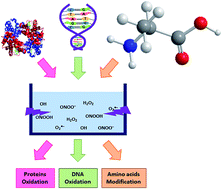Effect of nanosecond-pulsed plasma on the structural modification of biomolecules†
Abstract
In this study, we generated reactive species (RS) (OH˙, H˙, NO˙, H2O2, ONOO−, ONOOH, O2˙−, HO2˙, NO2−) through the use of nanosecond-pulsed plasma (NPP). In order, to understand the action of NPP on biomolecules, we have studied circular dichroism (CD) spectroscopy (spectral and thermodynamic analysis), gel electrophoresis, 1D NMR, matrix-assisted laser desorption/ionization time-of-flight mass spectrometry (MALDI-TOF MS) and Liquid Chromatograph/Capillary Electrophoresis-Mass Spectrometer (LC/CE-MS) for quantitative and qualitative bioanalysis. The measurements revealed that the RS generated by the NPP structurally modified the proteins [myoglobin (Mb) and hemoglobin (Hb)], amino acids [lysine (Lys), L-proline, L-threonine (Thr), L-asparagine (Asn), L-glutamic acid (Glu) and glycine] and calf thymus DNA. After the discharge, the thermodynamic profile of Hb exhibited more changes compared to Mb. Furthermore, we examined the protein carbonylation/oxidation to understand the structural modification for both proteins after NPP treatment. Moreover, we also observed the oxidation in calf thymus DNA after the NPP treatment. As a result, these studies extend the scope for next generation plasma-based treatments and understanding of the mechanism of NPP on biomolecules.


 Please wait while we load your content...
Please wait while we load your content...